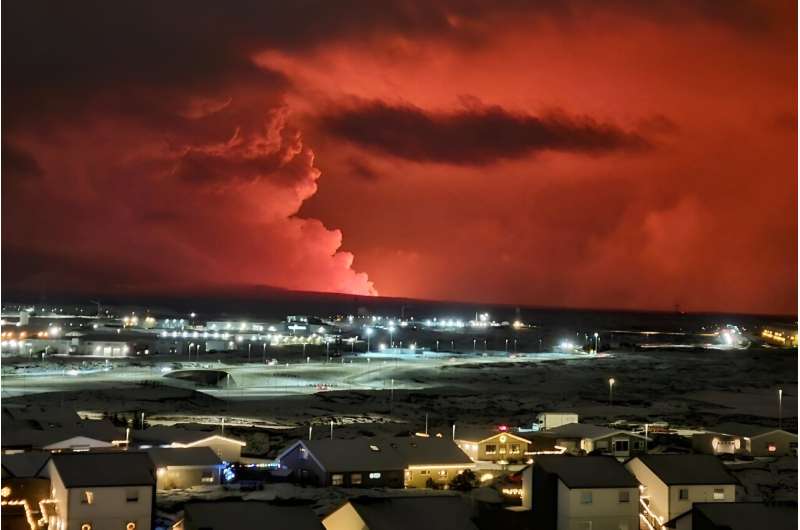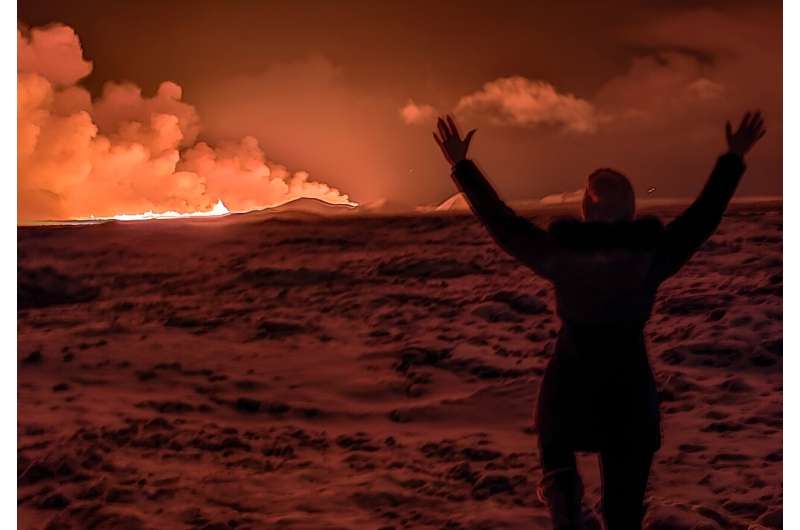This article has been reviewed according to Science X's editorial process and policies. Editors have highlighted the following attributes while ensuring the content's credibility:
fact-checked
reputable news agency
proofread
Iceland volcano eruption calms as lava flow eases

An Icelandic volcano that erupted and spewed lava into the sky overnight near a power plant was less active Tuesday evening, after weeks of intense seismic activity southwest of Reykjavik.
The eruption, only three kilometers (1.8 miles) from the evacuated fishing port of Grindavik on the Reykjanes peninsula, began Monday at around 10:17 pm (2217 GMT) after a "swarm" of small tremors, the Icelandic Meteorological Office (IMO) said.
The volcano opened a fissure in the ground about four kilometers long, with the southern end just three kilometers from Grindavik.
In an update on Tuesday at 1830 GMT, the IMO said the eruption continued to weaken.
"New aerial images of the area show that there are now three vents erupting southeast of Stora-Skogfell, down from the previous five," the meteorological office said, but added that it anticipated further lava flows along the fissure.
Amid weeks of warnings from scientists, the authorities built reinforcements around the Svartsengi geothermal plant, which is just two kilometers from the eruption.
It supplies electricity and water to 30,000 people on the peninsula.
"The land in Svartsengi subsided more than five centimeters," the IMO said in its 1830 GMT update.
"Previously, the land had risen there by about 35 centimeters since the formation of the magma channel on November 10," it added.
Live-streamed footage of the eruption showed glowing orange jets of lava spewing from a gash in the ground, surrounded by billowing clouds of red smoke against the dark winter sky.
In December, the sun rises around 11:00 am in the area just south of the Arctic Circle, and sets around 3:00 pm.
For weeks, experts had been anticipating an eruption in the area some 40 kilometers (25 miles) from the capital Reykjavik, prompting the authorities to evacuate thousands of people.
The nearby Blue Lagoon geothermal spa, famed for its turquoise waters, is closed to visitors.
Vidir Reynisson, head of the Department of Civil Protection, urged people to stay away from the area, telling a local television station: "This is no tourist eruption."
On Tuesday evening, tourists gathered on a hillside behind the closed road leading to Grindavik.
"It's not made by humans, it's totally mother nature itself," said Leo Kill, a 31-year-old Korean.

"That's why you just feel so tiny, you just can't do anything in front of this nature".
The volcano, which has yet to be given a name, was located near the Sundhnukagigar crater row.
Unlike the major Icelandic eruption in 2010 that grounded thousands of flights across Europe and North America, this one did not create an ash plume. Reykjavik's international airport remained open Tuesday.
New era
Since October, thousands of earthquakes had been detected on the Reykjanes peninsula, a possible precursor to an impending volcanic eruption.
"Right now there is no immediate risk of infrastructure being threatened," Grindavik mayor Fannar Jonasson told the daily Morgunbladid on Tuesday.
Roughly 4,000 people were evacuated from Grindavik on November 11 after scientists said a tunnel of magma was shifting beneath them.
The series of small earthquakes—sometimes hundreds per day—had damaged roads and buildings, an AFP reporter in Grindavik said.
Authorities have organized occasional trips to the village since, allowing those with homes in the most perilous parts to rescue everything from cherished pets to photo albums, furniture and clothing.
Volcanic eruptions are not uncommon in Iceland, which is home to 33 active volcano systems, the highest number in Europe.
But the Reykjanes peninsula had not experienced an eruption for eight centuries until 2021.
Since then, eruptions have struck in 2021, 2022 and earlier this year—all in remote, uninhabited areas.
With no danger to infrastructure or lives, they drew large crowds of visitors.
Volcanologists say this could be the start of a new era of activity in the region.
In 2010, the eruption of Iceland's long-dormant Eyjafjallajokull volcano—an ice-capped volcano more than 1,660 meters tall—shot huge amounts of ash into the atmosphere. Although no one died, it forced the cancellation of around 100,000 flights and left more than 10 million travelers stranded.
Situated in the North Atlantic, Iceland straddles the Mid-Atlantic Ridge, a crack in the ocean floor separating the Eurasian and North American tectonic plates.
© 2023 AFP





















